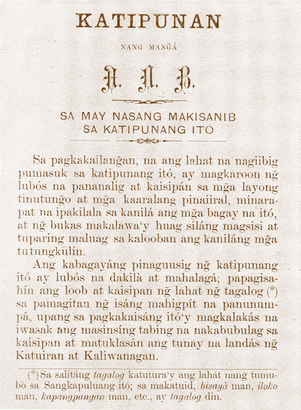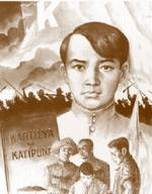The Katipunan Ideology
" A nation is born into freedom on the day when such a people, moulded into a nation by a process of cultural evolution and sense of oneness born of common struggle and suffering, announces to the world that it asserts its natural right to liberty and is ready to defend it with blood, life, and honor."
|
|

When President Diosdado Macapagal signed Proclamation No. 28 in 1962 declaring June 12 as Independence Day, (replacing July 4) public attention suddenly shifted to the significance of the 1896 revolution. This revolution was not spontaneous; rather, the high point of a long struggle, punctuated by numerous but unsuccessful uprisings, until national consciousness was fully awakened by the public execution of Filipino priests, Gomes, Burgos and Zamora (Gomburza) in the aftermath of the Cavite Mutiny of 1872. Believed to be innocent, their death caused intense hatred of the Spanish friars and the emergence of Filipino activists like Marcelo del Pilar and Graciano Lopez Jaena, whose work continued even as they fled to Spain to escape persecution. From Madrid was waged a pro-Filipino campaign for colonial reforms until worsening social conditions and unabated oppression bred a separatist movement that was the Katipunan.
The Katipunan was for a long time, best remembered by school children in Gregorio F. Zaide’s history textbook, for the so-called August 26, 1896 Cry of Balintawak—made momentous and dramatic by the mass tearing of cedulas personal. Other historians like Teodoro Agoncillo, later challenged this claim (his version was August 23, 1896 at Pugad Lawin), and soon, as other accounts surfaced, the date and place of its actual occurrence became a national controversy. But the Katipunan was not just a cry for freedom. It was a national aspiration made flesh. It caught the passion of ordinary people, willing to stake their lives and overcome the dread of reprisals; believing that worse fate awaited their families if they did not stand up to face their oppressors. It was a secret society that had a formal hierarchy composed of a supreme council and local councils, and a ritual of membership often mistaken for Masonry. Moreover, it had an ideology embodied in its Ang Kartilya ng Katipunan, authored by Emilio Jacinto. 
It was Andres Bonifacio who first formulated a code of conduct and to whom the Dekalogo ng Katipunan was attributed. But it was not published; instead, it was said that upon reading the Kartilya drafted by Jacinto, Bonifacio decided that it was superior to his Dekalogo, and adopted it as the official primer of the Katipunan. Emilio Jacinto, then became the chief theoretician and adviser of Bonifacio and later earned for him the title Brains of the Katipunan. Joining the Katipunan in 1894, he was the youngest member and nicknamed, according to historian Dr Isagani R. Medina (1992), Emiliong Bata to distinguish him from Emiliong Matanda, or Emilio Aguinaldo.
The Dekalogo had only ten points and dealt primarily with one’s duties to God, country, family, neighbor, the Katipunan and himself. It spoke of honor, charity and self-sacrifice but warned of penalty to the traitor and disobedient. The Kartilya was longer, more literary and philosophical. It presented its concept of virtuous living as lessons for self reflection, rather than as direct prescriptions. It asserted that it was the internal, not the external qualifications that make human greatness. In the third statement, Jacinto defined true piety (kabanalan) as charity, love for one another, and actions, deeds and speech guided by judicious reasons (“talagang katuiran”, literally, true reason). Written more than a hundred years ago at a time when the idea of nationhood was still a dream, the Kartilya reflected a vision, “bright sun of freedom in the islands, spreading its light upon brothers and a race united.”
The Kartilya can be better appreciated in its original Tagalog form because its essence was expressed using Tagalog syntax. It should also be appreciated within the context of the social and political environment of that colonial era, amid local traditions, spiritual beliefs, family concepts and ethnic diversity. In an article of the quarterly Sulyap Kultura (1996, National Commission for Culture and the Arts,) author Ed Aurelio Reyes cited Virgilio S. Almario, (2003 national artist for literature) from the latter’s book, Panitikan ng Rebolusyong 1896. According to Reyes, Almario described three distinct sources of the Katipunan’s philosophy or ideology: the Propaganda Movement, the great wealth of pre-colonial indigenous folklore, and the protest Christianity represented by the protest “Pasyon” and such proto-nationalist movements as Hermano Pule’s (Apolinario de la Cruz, 1815-1841) Cofraida de San Jose and the kapatiran-type (brotherhood) community organization around Mt Banahaw, San Cristobal and Makiling. The reference sources of the Kartilya included the French Revolution’s “Rights of Man and the Citizen” (predecessor of the 1948 Universal Declaration of Human Rights), which Jose Rizal reportedly translated into “Mga Karapatan ng Tawo (Tao)” and was circulated in the Philippines shortly before the founding of the Katipunan. Other sources included passages from the protest “Pasyon,”and elements from indigenous practices and bonds of kinship. Instead of simply reproducing Karapatan ng Tawo, Jacinto and Bonifacio adapted and changed it in order that it may be implanted more deeply into the minds and hearts of Katipunan followers. |
Emilio Jacinto
Emilio Jacinto was a nineteen year old law student at the University of Santo Tomas when he joined the Katipunan in 1894. He could have been a brilliant lawyer like Apolinario Mabini but his schooling was cut short when he committed himself fully to the ideals and work of the movement. He was the nephew of Jose Dizon one of the founders of the Katipunan. He was born in Trozo, on December 15, 1875 to Mariano Jacinto and Josefa Dizon. When his father died, his mother a midwife, worked hard to support his studies until later, he lived with his uncle, Jose Dizon, who enrolled him at the Colegio de San Juan de Letran in Intramuros. He then transferred to the University of Santo Tomas to take up Law.
Jacinto became a close friend and adviser of Andres Bonifacio. He wrote the Kartilya ng Katipunan which became not only a primer for members, but an ideology, embodying moral and nationalistic principles. He was also a poet. He wrote literary pieces, the most famous of which was the patriotic A La Patria, in October, 1897, signed Dimas-ilaw. It was inspired by Jose Rizal’s Mi Ultimo Adios. He edited the Katipunan revolutionary paper, Ang Kalayaan (Freedom) and wrote Pahayag or Manifesto which appeared in its only issue. The paper held office at the house occupied by Dr. Pio Valenzuela in Calle Lavezares, San Nicolas, Binondo. The first and only issue of Ang Kalayaan though dated January, was released in March 1896. To mislead the authorities, the paper was datelined Yokohama and its editor was listed as Marcelo H. Pilar. But the ruse was not only in the editorial box; Jacinto used a writing style remarkably similar to the style and language of del Pilar. __________________________________ Click to read: Related readings:
_____________________________________ 
Republic Act No. 4166 prescribing June 12 as Philippine Independence Day was signed into law by President Macapagal on August 4, 1964. The bill was authored by House Representatives Ramon Mitra, Sr. and Justiniano Montano. Senator Lorenzo Tañada authored a similar measure in the Senate. _____________________________________
|